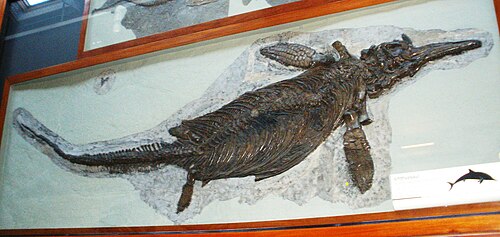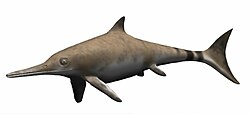Ichthyosaurus
Ichthyosaurus was an extinct marine reptile from the Lower Jurassic. It was the first member of the order Ichthyosauria to be discovered. The first complete skeleton was discovered in the early 19th century (1810/11) by Mary Anning in the Dorset Jurassic Coast. Many more specimens were found in Europe, especially from the limestone quarries in Holzmaden, southern Germany.
| Ichthyosaurus Temporal range: Late Triassic - Early Jurassic,
| |
|---|---|

| |
| Fossil specimen of I. communis | |
| Scientific classification | |
| Unrecognized taxon (fix): | Ichthyosauridae |
| Genus: | Ichthyosaurus De la Beche & Conybeare, 1821 |
| Type species | |
| †Ichthyosaurus communis De la Beche & Conybeare, 1822
| |
| Other species | |
Ichthyosaurus lived from about 199 to 189 million years ago (mya). This sleek animal could perhaps swim at speeds up to 25 mph (40 kph).
Mode of life
Live birth
Ichthyosaurus bore live young. This we know from fossil evidence. It was thought at first that Ichthyosaurus laid eggs on land, but fossil evidence shows that the females gave birth to live young. Because they did, their life habit could be entirely aquatic. They were well-adapted to life as fully pelagic organisms because they never needed to come onto land. The babies were born tail first to prevent them from drowning in the water.[2]
Hundreds of well-preserved, fossilised skeletons have been found in Jurassic rock at Holzmaden. Some of the bones were still articulated. Some fossils still had baby specimens inside them, indicating that Ichthyosaurus was viviparous. Similar finds in the related Stenopterygius also show this.[2][3]
Fins
The German fossils also featured the outline of Ichthyosaurus skin, showing it had a fleshy dorsal fin on its back and a large caudal fin. Other ichthyosaur fossils proved this feature was not limited to Ichthyosaurus.
Sense organs
Ichthyosaurus ear bones were solid, probably transferring water vibrations to the inner ear. Still, hunting by sight was the creature's main feeding activity; it had huge, sensitive eyes, protected by bony shields.
Feeding
Coprolites (fosillized excreta) of Ichthyosaurus show its diet consisted of fish and squid.[4]
Ichthyosaurus Media
Cast of the first known complete Ichthyosaurus specimen (originally referred to as Proteosaurus), which was destroyed during WW2
- Scuba33.jpg, which is by NOAA and in the public domain.*References* * Massare, J.A.; Lomax, D.R. (2017). "
Life restoration of I. communis
Historically important sculpture of I. communis (left) in Crystal Palace Park
References
- ↑ 1.0 1.1 Dean R. Lomax; Judy A. Massare (2016). "Two new species of Ichthyosaurus from the lowermost Jurassic (Hettangian) of Somerset, England". Papers in Palaeontology. 3: 1–20. doi:10.1002/spp2.1065. S2CID 89567182.
- ↑ 2.0 2.1 Böttcher R. 1990. Neue Erkenntnisse über die Fortpflanzungsbiologie der Ichthyosaurier. Stuttgarter Beiträge zur Naturkunde Serie B (Geologie und Paläontologie) 164: 1-51
- ↑ Martill D.M. 1993. Soupy substrates: a medium for the exceptional preservation of Ichthyosaurs of the Posidonia Shale (Lower Jurassic) of Germany. Kaupia - Darmstädter Beiträge zur Naturgeschichte 2: 77-97
- ↑ Palmer, D., ed. (1999). The Marshall Illustrated Encyclopedia of dinosaurs and prehistoric animals. London: Marshall Editions. p. 80. ISBN 1-84028-152-9.






